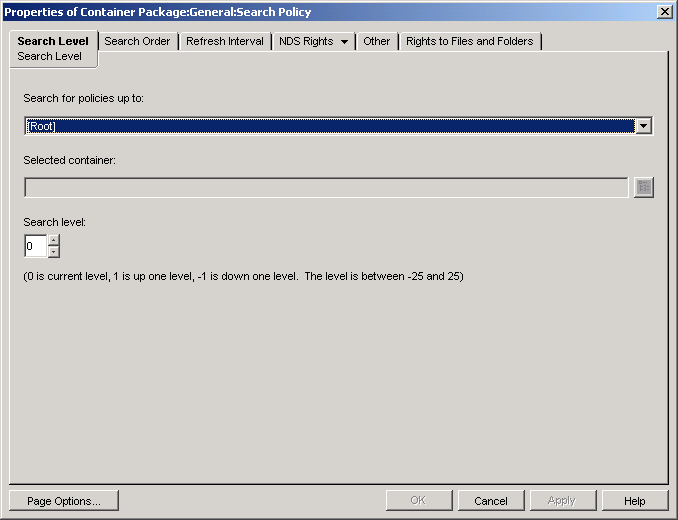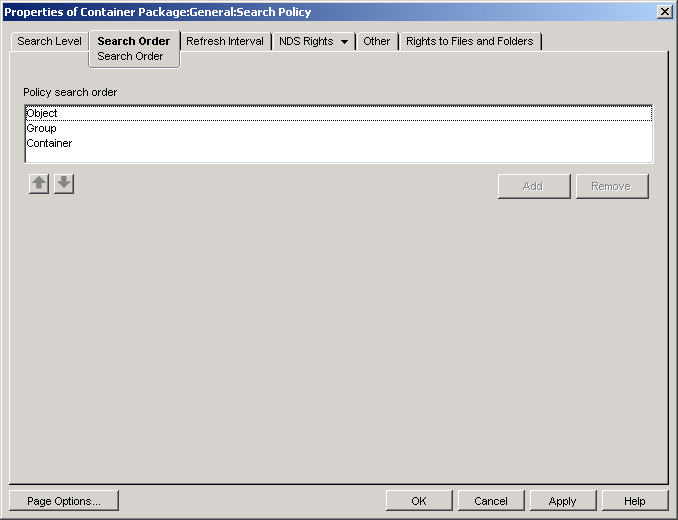12.0 Setting Up the Search Policy in the Container Package
The Container Package contains only the Search policy. The Search policy is used to limit how far up the tree Desktop Management searches for the effective policies.
The Search policy provides the following benefits:
-
Improved security
-
The ability to reorder a search
-
Better search performance by limiting the search levels traversed in Novell® eDirectory™ and by avoiding unnecessary LAN traffic
The Search policy locates policy packages that are associated with containers. To make a Search policy effective, you associate it with a container.
You can specify the number of levels above or below the location to begin the search:
Table 12-1 Search Policy Levels
|
Number |
Description |
|---|---|
|
0 |
Limits the search to the selected level. |
|
1 |
Limits the search to one level above the selected level. For example, if you selected the server's parent container, this limits the search to one level above the parent level. |
|
‑1 |
Limits the search to one level below the selected level. For example, if you selected [Root], -1 would limit the search to one level below [Root]. |
Without a Search policy in effect, the default is to search from the parent container to [Root]. The search checks each container up the tree towards [Root] for policy packages associated with those containers.
The default Search policy recognizes the policy package associated with the User or Workstation object before it looks in any group or container where such an object resides.
The default search order, , can be reordered and can include as few as one of the locations. For instance, you can exclude Group objects by setting the search order to .
You can avoid unnecessary LAN traffic by searching to an associated or selected container instead of [Root].
When you view the associated policy packages for an object, by default Desktop Management starts at the object and searches up the tree to [Root] for all policy packages associated with:
-
The object
-
Any Group where the object has membership
-
Any of the object’s parent containers
The Search policy is required to limit the range which is being used to find other policies. You set up Search policies at a container level. Set up as many Search policies as you need to help minimize network traffic.
To set up a Search policy:
-
In ConsoleOne®, right-click the Container Package, then click .
If you have not yet created the Container Package, see Creating Policy Packages.
-
Select the check box under the column for the Search policy.
This both selects and enables the policy.
-
Click to display the Search Level Page.

-
Using the drop-down list, select the level to search up to:
[Root]: Searches from the object to the root of the tree.
Object Container: Searches to the parent container of the Server, User, or Workstation object.
Associated Container: Searches to the associated container that this Search policy is associated with. The Associated Container level replaces Partition in earlier versions of ZENworks® for Desktops.
If you are upgrading from a previous version, and you use Partition in your Search policy, make sure that the Container Package is associated only to the partition root.
Selected Container: Searches from the object to the selected container.
-
(Conditional) If you chose Selected Container, browse for and select the container.
-
To determine the searching limits in either direction, specify a number in the Search Level box:
Number
Description
0
Limits the search to the selected level. This is the default setting.
1
Limits the search to one level above the selected level.
For example, if you selected the server's parent container, this would limit the search to one level above the parent level.
‑1
Limits the search to one level below the selected level.
For example, if you selected [Root], -1 limits the search up to one level below [Root].
You can specify any number between -25 and 25, but using the default setting of 0 is a good administrative practice.
-
Click the tab.

-
Specify the policy searching order using the arrow keys, the button, and the button as necessary.
The default search order is .
-
Click the tab.

-
Specify the frequency for how often the server should refresh its policies.
By default, the option is enabled and the refresh interval is set to one hour. If you set both time increments to zero (0), policies are never refreshed, even if you have the option enabled.
-
Click .
-
Click the tab, then click .
-
Browse for and select the container object for association to the Search policy.
-
Click when finished.